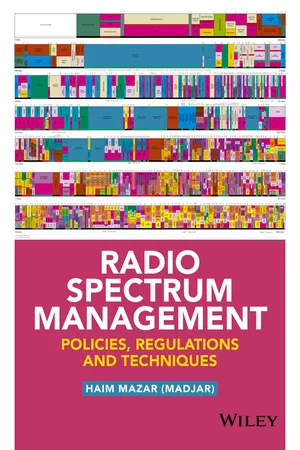
- English
- ePUB (mobile friendly)
- Available on iOS & Android
About this book
This book presents the fundamentals of wireless communications and services, explaining in detail what RF spectrum management is, why it is important, which are the authorities regulating the use of spectrum, and how is it managed and enforced at the international, regional and national levels. The book offers insights to the engineering, regulatory, economic, legal, management policy-making aspects involved. Real-world case studies are presented to depict the various approaches in different countries, and valuable lessons are drawn. The topics are addressed by engineers, advocates and economists employed by national and international spectrum regulators. The book is a tool that will allow the international regional and national regulators to better manage the RF spectrum, and will help operators and suppliers of wireless communications to better understand their regulators.
Frequently asked questions
- Essential is ideal for learners and professionals who enjoy exploring a wide range of subjects. Access the Essential Library with 800,000+ trusted titles and best-sellers across business, personal growth, and the humanities. Includes unlimited reading time and Standard Read Aloud voice.
- Complete: Perfect for advanced learners and researchers needing full, unrestricted access. Unlock 1.4M+ books across hundreds of subjects, including academic and specialized titles. The Complete Plan also includes advanced features like Premium Read Aloud and Research Assistant.
Please note we cannot support devices running on iOS 13 and Android 7 or earlier. Learn more about using the app.
Information
1
The Radio Frequency Spectrum and Wireless Communications
1.1 Historical Overview
1.2 A General Communication Channel

1.3 Radio Frequency Bands
| Band number | Symbols | Frequency range | Metric subdivision |
| 4 | VLF | 3–30 kHz | Myriametric waves... |
Table of contents
- Cover
- Title Page
- Table of Contents
- About the Author
- Foreword
- Preface
- Acknowledgments
- Acronyms and Abbreviations
- 1 The Radio Frequency Spectrum and Wireless Communications
- 2 The Main Regulated Radio Services
- 3 Short Range Devices and the License‐Exempt RF Spectrum
- 4 Policies, Legal and Economic Frameworks to Manage the RF Spectrum
- 5 RF Engineering and the Link Budget
- 6 International RF Spectrum Management and Standardization
- 7 Regional RF Spectrum Management
- 8 National Spectrum Management
- 9 Limitations to Radio Frequency Human Exposure
- Index
- End User License Agreement